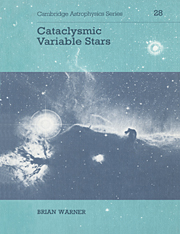3 - Dwarf Novae
Published online by Cambridge University Press: 23 December 2009
Summary
The DN, already introduced in Sections 1.2 and 1.3 with their classification scheme described in Section 2.1, are arguably the most valuable of objects for the study of accretion discs. Among them examples may be found of optically thin discs and optically thick discs, of face-on discs and edge-on discs, of non-steady discs and of nearly steady state discs and of transitions between them. Furthermore, the brightest DN at maxima reach apparent magnitudes of 8–10, at which time the entire flux is conveniently of almost pure accretion origin.
Well-Observed DN
It is inevitable that a few relatively bright DN, especially the eclipsing systems, have been preferentially observed. Although over 200 DN have been classified by their light curves, only a small fraction have been studied sufficiently to establish their orbital periods. It will be seen in this chapter that POrb plays an important rôle in the systematics of DN. Among the DN in general, 12 Z Cam stars, 29 definite U Gem stars (including, slightly unconventionally, the three systems BV Cen, GK Per and V1017 Sgr with large POrb), 34 SU UMa stars and 22 objects suspected of belonging in the DN class have known orbital periods. The SU UMa stars may be overrepresented because their orbital periods are easy to estimate, independent of inclination, from photometric observations made during super outbursts. Orbital periods for the U Gem and Z Cam class have come predominantly from spectroscopic observations, with the addition of a few found from photometric orbital variations (eclipses, bright spot modulation, IR ellipsoidal modulation).
- Type
- Chapter
- Information
- Cataclysmic Variable Stars , pp. 126 - 215Publisher: Cambridge University PressPrint publication year: 1995
- 2
- Cited by

